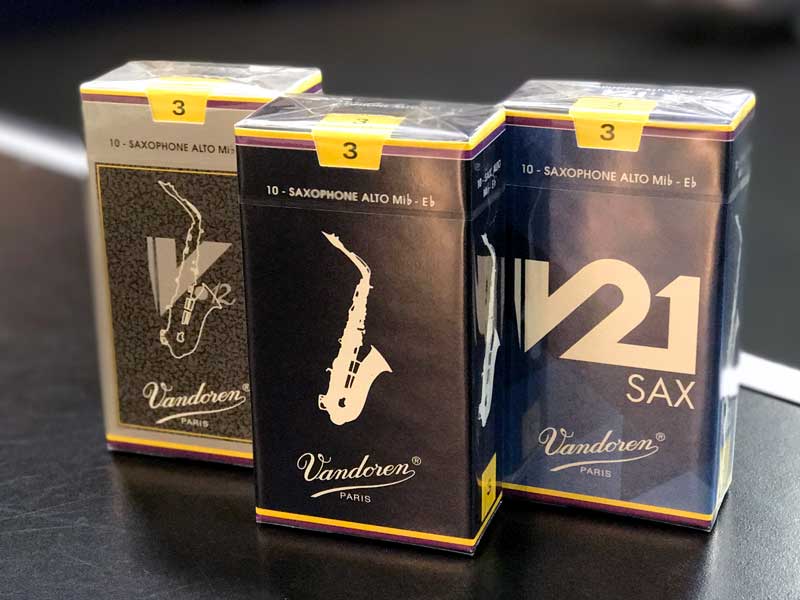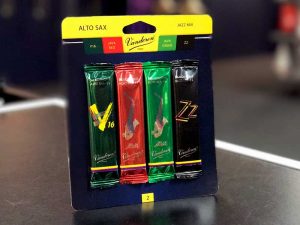Vandoren Saxophone Reed Guide
One of the questions we frequently receive is “which reed is best for me?” Vandoren has forged a reputation as an elite maker of quality reeds for clarinet and saxophone that work right out of the box. Each type of reed is designed with a specific sound quality in mind. If you were wondering what each reed is designed for, here is a detailed description for each type of reed!

“Classical” Reeds
Traditional
This reed is designed to produce a quality, extremely pure sound due to a very thin reed tip (the area of reed with maximum vibration), balanced by a solid vertebral column (more cane in the area which climbs gradually to the heel). Traditionals feature the thinnest tip with the thickest heart, resulting in crisp articulation with a full, dark sound.
V12
The success of V12 reeds in the clarinet world for 25 years has led us to transpose their characteristics and advantages into the saxophone world. With its very precise attack, homogeneous timbre in every register, controlled high notes, warm and velvety sound, this new reed offers exceptional possibilities. Produced from cane selected for its specific proportions, the V12 reeds have a thicker heel and are cut on a longer palette with a slightly thicker tip than the Traditional. The longer palette means that more of the reed is vibrating, resulting in a deeper, richer sound. The thicker tip gives body to the attack and increases the longevity of the reed.
V21
This unfiled reed is the first saxophone reed with a conical shape. It offers a clean, particularly warm and centered sound while providing an excellent sound projection. The V21 reed allows precise articulation and great ease in achieving large interval leaps.

“Jazz” Reeds
Java “Green”
Developed in 1983 for jazz and popular music. A thicker tip and a more flexible palette* than the Traditional reed allow vibration over a larger surface area with maximum elasticity. This type of vertebral column gives the musician much greater playing flexibility, as the resultant elasticity zone is very large. JAVA reeds are more flexible than Traditionals and V16s and vibrate on a long palette, creating a bright sound with immediate response.
* Palette: zone where the waves are propagated with the greatest range. From the tip, the waves are absorbed further in the JAVA reed.
Java “Red”
The driving force behind the JAVA “Filed – Red Cut” design was to offer more sonic possibilities to musicians while keeping the qualities of the original Java. More flexible than its elder version, with a little more tonal body, the JAVA “Filed – Red Cut” offers a full, rich, centered sound and excellent projection with an extremely precise attack. A relative of the JAVA reed family, the JAVA “Filed – Red Cut” is the first file cut Vandoren reed for jazz and popular music. It also benefits from a completely new design.
V16
Launched in 1993 to answer the demand of some American jazz musicians (a JAVA with even more wood). The V16 has a thicker tip than the traditional Vandoren reeds and a longer palette. The sound is more brilliant, more percussive, and particularly well adapted to all the new styles of music. V16 reeds have a medium-thick heart (more than JAVA but less than Traditionals), with a profile designed for producing a strong attack with a deep, rich sound.
ZZ
Developed in 2002, the ZZ jazz reed is immediately responsive without sacrificing the brightness or tone quality required for this style of music. The unique relationship between the heart and tip provides extraordinary color, great response and a durable life. ZZ reeds combine the medium-thick heart, spine, and rounded tip of the V16 with the flexible palette design of the JAVA, giving the player a rich, colorful sound with quick response.
If you are looking to try these reeds, Paige’s Music offers a Vandoren Jazz Mix Pack featuring the Java “Green”, Java “Red” V16, and ZZ reeds. These mix packs are available in 2, 2 ½, 3, and 3 ½ strengths for alto and tenor saxophone.


4 Comments
Greg W
about 7 years agoThe last few boxes i have purchased had 1 decent reed. Someone recommended that I should get a reed shaver. Should i have to go through this trouble to get a good sounding reed? Why has the quality gone down and down over the years?
Sam Motter
about 7 years agoHi Greg, As a fellow saxophonist, I feel your pain! Unfortunately, as reed cane is an organic material, slight variations in strength and density from reed to reed and even within each reed itself are something that we have to deal with as saxophone players. There are plenty of tricks (such as reed shavers, clippers, different storage techniques, different methods of breaking in reeds, even repositioning the reed on the mouthpiece in a pinch) that players employ to adjust reeds to their comfort level and tonal preference. For some players, the extra time and energy is worth it. Others have explored less unpredictable options, like synthetic reeds. This is a fairly nuanced subject that I’d be happy to discuss with you over the phone! If you’d like to give our store a call at 800-382-1099, just ask for Sam and we can talk reeds, mouthpieces, and whatever else I can help you out with.
Gavin C
about 4 years agowhat reed is best for switching between jazz music and more modern music
Trevor
about 3 years agoHello Gavin, Typical a jazz reed will work for both jazz and modern music. I would recommend trying out the Vandoren V16 or D'Addario jazz select! Thanks, Trevor M.